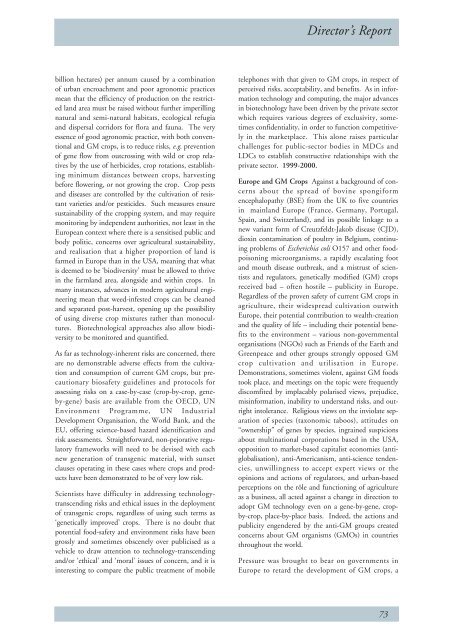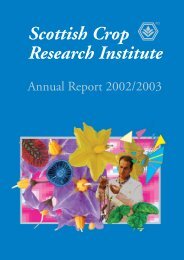SCRI Annual Report 2003/2004 - Scottish Crop Research Institute
SCRI Annual Report 2003/2004 - Scottish Crop Research Institute
SCRI Annual Report 2003/2004 - Scottish Crop Research Institute
Create successful ePaper yourself
Turn your PDF publications into a flip-book with our unique Google optimized e-Paper software.
Director’s <strong>Report</strong><br />
billion hectares) per annum caused by a combination<br />
of urban encroachment and poor agronomic practices<br />
mean that the efficiency of production on the restricted<br />
land area must be raised without further imperilling<br />
natural and semi-natural habitats, ecological refugia<br />
and dispersal corridors for flora and fauna. The very<br />
essence of good agronomic practice, with both conventional<br />
and GM crops, is to reduce risks, e.g. prevention<br />
of gene flow from outcrossing with wild or crop relatives<br />
by the use of herbicides, crop rotations, establishing<br />
minimum distances between crops, harvesting<br />
before flowering, or not growing the crop. <strong>Crop</strong> pests<br />
and diseases are controlled by the cultivation of resistant<br />
varieties and/or pesticides. Such measures ensure<br />
sustainability of the cropping system, and may require<br />
monitoring by independent authorities, not least in the<br />
European context where there is a sensitised public and<br />
body politic, concerns over agricultural sustainability,<br />
and realisation that a higher proportion of land is<br />
farmed in Europe than in the USA, meaning that what<br />
is deemed to be ‘biodiversity’ must be allowed to thrive<br />
in the farmland area, alongside and within crops. In<br />
many instances, advances in modern agricultural engineering<br />
mean that weed-infested crops can be cleaned<br />
and separated post-harvest, opening up the possibility<br />
of using diverse crop mixtures rather than monocultures.<br />
Biotechnological approaches also allow biodiversity<br />
to be monitored and quantified.<br />
As far as technology-inherent risks are concerned, there<br />
are no demonstrable adverse effects from the cultivation<br />
and consumption of current GM crops, but precautionary<br />
biosafety guidelines and protocols for<br />
assessing risks on a case-by-case (crop-by-crop, geneby-gene)<br />
basis are available from the OECD, UN<br />
Environment Programme, UN Industrial<br />
Development Organisation, the World Bank, and the<br />
EU, offering science-based hazard identification and<br />
risk assessments. Straightforward, non-pejorative regulatory<br />
frameworks will need to be devised with each<br />
new generation of transgenic material, with sunset<br />
clauses operating in these cases where crops and products<br />
have been demonstrated to be of very low risk.<br />
Scientists have difficulty in addressing technologytranscending<br />
risks and ethical issues in the deployment<br />
of transgenic crops, regardless of using such terms as<br />
‘genetically improved’ crops. There is no doubt that<br />
potential food-safety and environment risks have been<br />
grossly and sometimes obscenely over publicised as a<br />
vehicle to draw attention to technology-transcending<br />
and/or ‘ethical’ and ‘moral’ issues of concern, and it is<br />
interesting to compare the public treatment of mobile<br />
telephones with that given to GM crops, in respect of<br />
perceived risks, acceptability, and benefits. As in information<br />
technology and computing, the major advances<br />
in biotechnology have been driven by the private sector<br />
which requires various degrees of exclusivity, sometimes<br />
confidentiality, in order to function competitively<br />
in the marketplace. This alone raises particular<br />
challenges for public-sector bodies in MDCs and<br />
LDCs to establish constructive relationships with the<br />
private sector. 1999-2000.<br />
Europe and GM <strong>Crop</strong>s Against a background of concerns<br />
about the spread of bovine spongiform<br />
encephalopathy (BSE) from the UK to five countries<br />
in mainland Europe (France, Germany, Portugal,<br />
Spain, and Switzerland), and its possible linkage to a<br />
new variant form of Creutzfeldt-Jakob disease (CJD),<br />
dioxin contamination of poultry in Belgium, continuing<br />
problems of Escherichia coli O157 and other foodpoisoning<br />
microorganisms, a rapidly escalating foot<br />
and mouth disease outbreak, and a mistrust of scientists<br />
and regulators, genetically modified (GM) crops<br />
received bad – often hostile – publicity in Europe.<br />
Regardless of the proven safety of current GM crops in<br />
agriculture, their widespread cultivation outwith<br />
Europe, their potential contribution to wealth-creation<br />
and the quality of life – including their potential benefits<br />
to the environment – various non-governmental<br />
organisations (NGOs) such as Friends of the Earth and<br />
Greenpeace and other groups strongly opposed GM<br />
crop cultivation and utilisation in Europe.<br />
Demonstrations, sometimes violent, against GM foods<br />
took place, and meetings on the topic were frequently<br />
discomfited by implacably polarised views, prejudice,<br />
misinformation, inability to understand risks, and outright<br />
intolerance. Religious views on the inviolate separation<br />
of species (taxonomic taboos), attitudes on<br />
“ownership” of genes by species, ingrained suspicions<br />
about multinational corporations based in the USA,<br />
opposition to market-based capitalist economies (antiglobalisation),<br />
anti-Americanism, anti-science tendencies,<br />
unwillingness to accept expert views or the<br />
opinions and actions of regulators, and urban-based<br />
perceptions on the rôle and functioning of agriculture<br />
as a business, all acted against a change in direction to<br />
adopt GM technology even on a gene-by-gene, cropby-crop,<br />
place-by-place basis. Indeed, the actions and<br />
publicity engendered by the anti-GM groups created<br />
concerns about GM organisms (GMOs) in countries<br />
throughout the world.<br />
Pressure was brought to bear on governments in<br />
Europe to retard the development of GM crops, a<br />
73
















